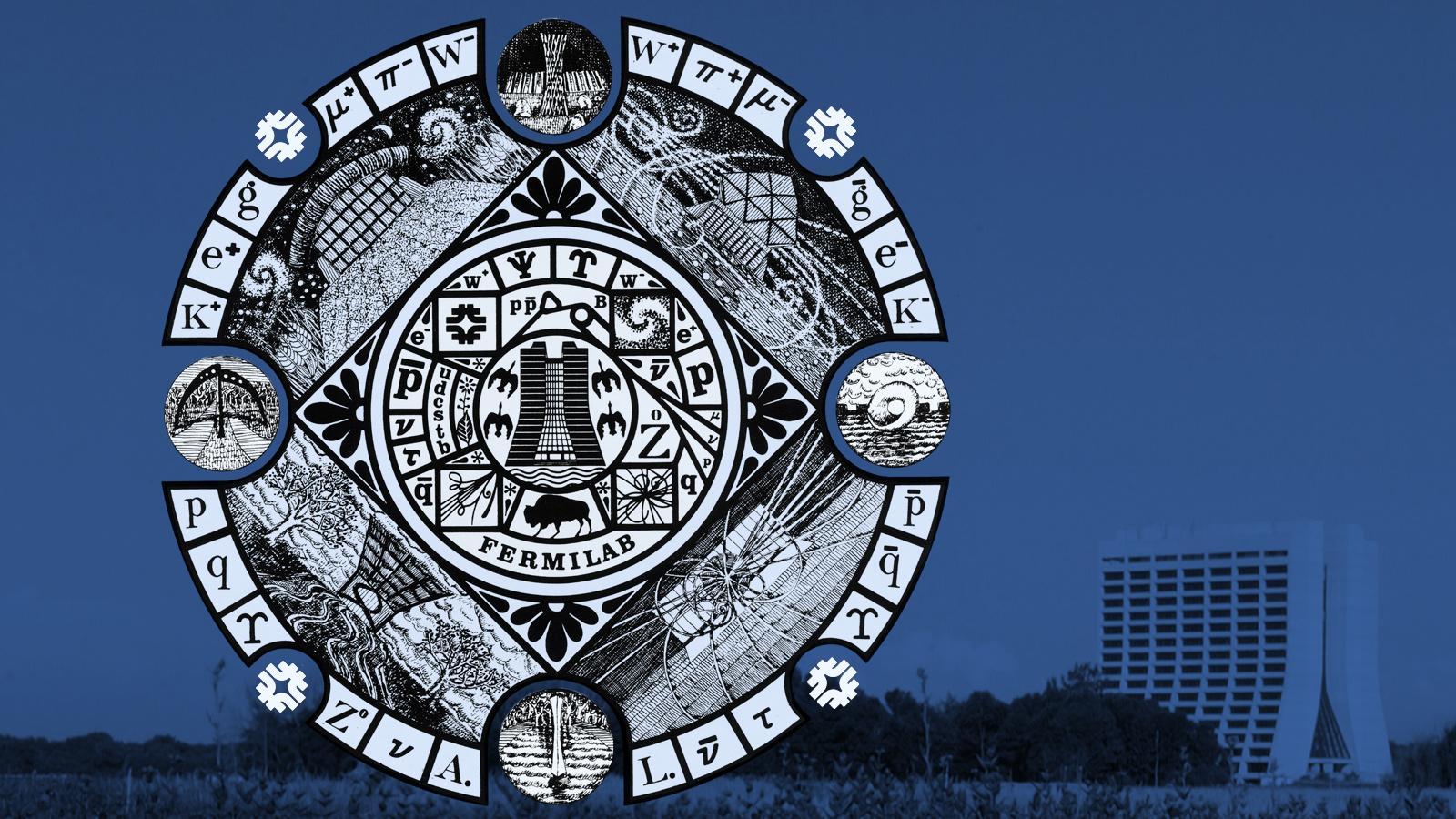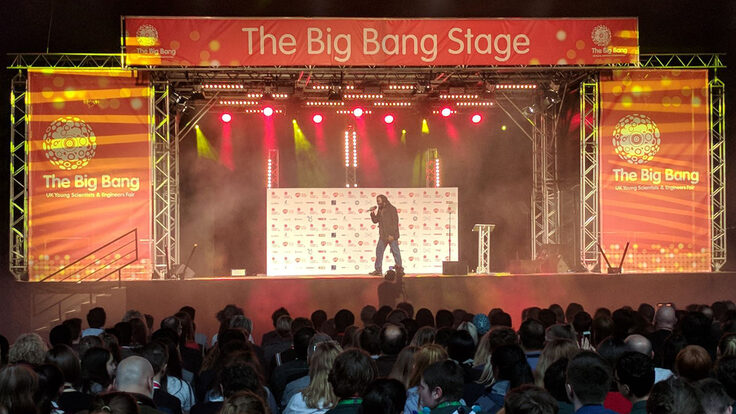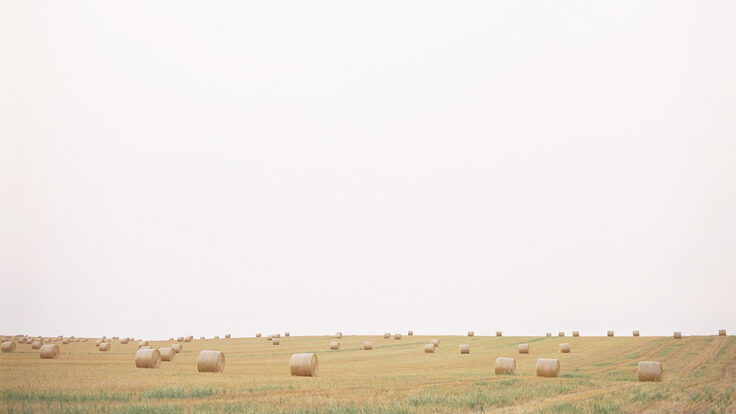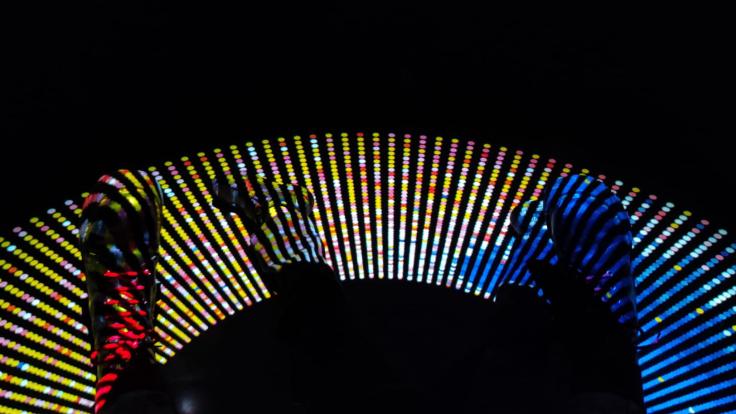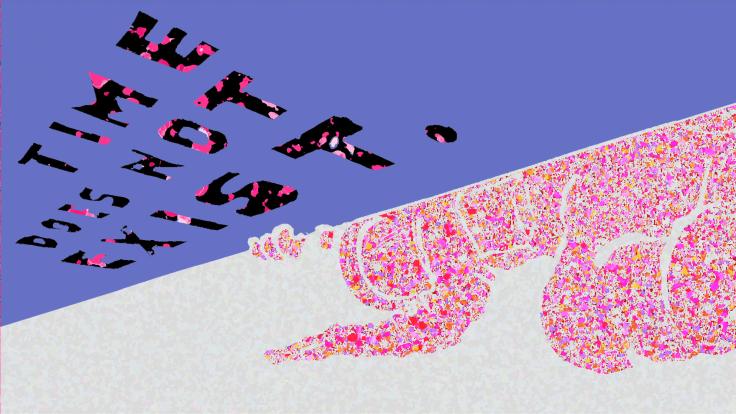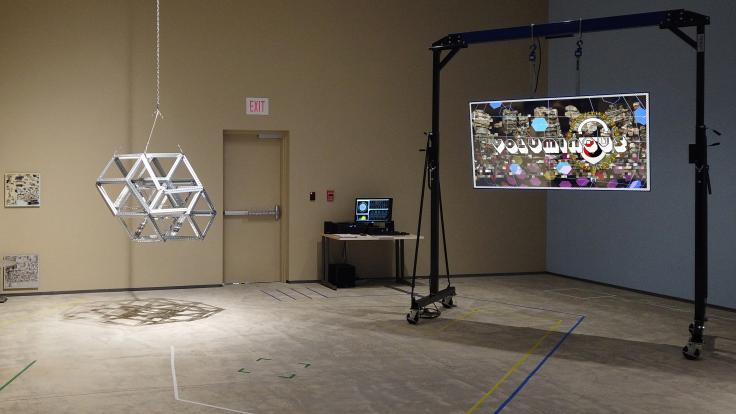When talking about Fermilab’s distinct visual and artistic aesthetic, it’s impossible not to mention Angela Gonzales. The artist – Fermilab’s 11th employee – joined the lab in 1967 and immediately began connecting the lab’s cutting-edge science with an artistic flair to match. She picked a color palette of bold blues and oranges and reds that would go on to adorn the campus’ buildings, and illustrated hundreds of posters, signs and report covers for the lab.
She also designed the iconic logo and a beautiful graphic that has become an unofficial seal for the laboratory, most commonly found on the back of T-shirts. But what do all of the symbols mean?



Wilson Hall
Perhaps the most iconic image related to Fermilab is the silhouette of the 16-story Wilson Hall. The building is named after Fermilab’s founding director, Robert Wilson, who (among many other responsibilities, such as overseeing the design and construction of the new particle accelerator complex) took a helicopter up to plot out the best aesthetic height for the central building on Fermilab’s 6800-acre campus. The concrete building has two independent, freestanding towers that are connected by a series of crossovers that rest on rollers.


Logo
Gonzales worked with Wilson to create Fermilab’s logomark. It unifies a dipole magnet, represented by two horizontal straight lines that indicate the north and south poles of the magnet, and a quadrupole magnet (represented by the four curved lines). Dipole and quadrupole magnets help guide and focus particle beams as they move through accelerators.


Tracks
These three boxes show different kinds of sights researchers at Fermilab encounter as they explore the building blocks of the universe. In the bottom left are the swirls of tracks created as particles smash into a fixed target and the resulting debris passes through a particle detector (such as a bubble chamber, pictured). In the lower right are tracks from a head-on particle collision created by Fermilab’s Tevatron collider and recorded by its CDF and DZero experiments. In the upper right box are the swirling arms of a galaxy, representing Fermilab’s particle astrophysics program. The smallest particles of matter build up to create the largest structures in the universe.


Accelerator complex
Hidden within this piece of art is something that even some Fermilab employees might not have picked up on: the lab’s particle accelerator chain. It started with protons in the Fermilab Linear Accelerator, the straight line leading into the small circle representing the Booster accelerator. From there, protons entered the Main Ring and then the Tevatron, or were fed to the triangular Antiproton Source, a nickel target that produced antiprotons when struck. Those protons (p) and antiprotons (p̄) would then collide in one of the two detectors on the Tevatron or head down the beamlines to the fixed-target areas, where researchers studied protons, neutrinos and mesons. Today Fermilab’s largest and most powerful accelerator is the Main Injector (pictured), a 2-mile ring that powers a new suite of particle experiments.


Prairie symbols
Fermilab is one of a handful of National Environmental Research Parks in the United States. The site contains hundreds of acres of ecosystems native to the Midwest, including tall grass prairie, oak savanna, woodlands and wetlands. The site is also home to coyotes, deer, birds (including the Canada geese depicted in the artwork), and, of course, bison. Wilson was a cowboy from Frontier, Wyoming, and he brought the first members of Fermilab’s bison herd to the site to represent the “frontier” of physics and the lab’s strong ties to the prairie.


Quarks
Quarks (q) are some of the fundamental building blocks of matter. The six known kinds are up, down, charm, strange, top and bottom (u, d, c, s, t, b), which combine to form different subatomic particles. (There is also an antiquark version (q̄) of each quark variety). The protons and neutrons that make up your atoms comprise a combination of up and down quarks. Researchers at Fermilab discovered the bottom quark in 1977 and the top quark in 1995. The above image shows then-director John Peoples discussing the top quark discovery with reporters. Today scientists use the SeaQuest experiment at Fermilab to study the presence of strange quarks in protons.


Leptons
Leptons make up another class of elementary particles. This class includes the electron (e) that powers your electronics and its heavier cousins, the muon (μ) and the tau (τ). It also includes the neutrino (ν), a lightweight, electrically neutral particle. Neutrinos are among the most abundant particles in the universe, second only to photons (particles of light), and pass through you all the time without interacting. Neutrinos have been a part of Fermilab’s fixed-target experiments (where they left tracks such as the pictured bubble chamber event) for decades and are the focus of the upcoming Deep Underground Neutrino Experiment. Fermilab is also constructing two new muon experiments, Muon g-2 and Mu2e.


Bosons
Our world is governed by various subatomic forces, which are transmitted by particles called bosons. The charged W+ and W- bosons and the neutral Z boson are the carriers of the weak force, which is responsible for how particles decay. Researchers were able to learn more about those carriers first by using fixed-target experiments and later by colliding protons and antiprotons in the CDF (pictured) and DZero detectors. Better understanding these particles and their characteristics (such as mass) helped physicists hunt for other particles predicted by theory, such as the Higgs boson.


Mesons
The two symbols at the top of the artwork represent types of mesons, which are particles made of one quark and one antiquark. The left is the J/Ψ, pronounced jay-psi, made of a charm quark and an anticharm quark. It was given two different names, both of which stuck, by the discoverers at Brookhaven and SLAC national laboratories. It revealed the existence of a fourth type of quark, the charm, and became an important part of research projects exploring theories of quark physics at laboratories around the world. The right symbol is the Υ, pronounced upsilon, a meson made of a bottom quark and an antibottom quark. The discovery of the Υ at Fermilab in 1977 by a team led by Leon Lederman (pictured) was the first experimental proof for the existence of the bottom quark.
Explore the symbols in this piece of Fermilab artwork
- Wilson Hall
- Logo
- Tracks
- Accelerator complex
- Prairie symbols
- Quarks
- Leptons
- Bosons
- Mesons
If all this symbolism isn’t enough for you—or if you’re a part of the coloring book craze and want to shade in a science drawing—fear not. Gonzales made an expanded version of this graphic. The buildings (clockwise from the top left) are the Meson Lab (now the Fermilab Test Beam Facility), the Geodesic Dome (now part of the Silicon Detector Facility), the CDF building (now part of the Illinois Accelerator Research Center) and the Pagoda (a small building that hosted a control room). She also incorporated four of the outdoor sculptures on the Fermilab site (clockwise from top): Tractricious, the Mobius Strip, Acqua Alle Funi and Broken Symmetry. You’ll also find some of the particle symbols from the core graphic, along with the symbols for π mesons, K mesons and gluons (g).
Download a high resolution version of the expanded artwork.




